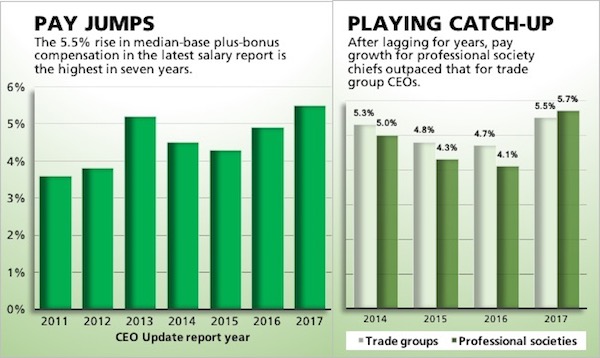CEO compensation increases the most since Great Recession
CEO compensation increases the most since Great Recession
- April 12, 2017 |
-
 CEO Update
CEO Update

Latest salary survey shows 5.5 percent gain in median base-plus-bonus pay for association execs, 5.7 percent at professional societies
RELATED CONTENT
CEO Salary Report
CEO Compensation increases the most since Great Recession
CEOs at smaller, regulated groups command big salaries
Half of incoming CEOs paid more than predecessor
Median association executive pay surged 5.5 percent in CEO Update's 2017 Salary Report, the highest rate of increase in at least seven surveys. Pay for professional society leaders rose slightly faster than for their trade group counterparts. The median compensation for all association CEOs in groups with more than $12 million revenue was $527,069.
The strong increase in compensation—documented in the latest IRS filings from fiscal years 2015 and 2016—reflects continued momentum coming out of the Great Recession, and experts don't expect the pace of gains to slow much unless the economy does.
James Wynn, principal at compensation consultant Quatt Associates, said association boards are opening their wallets in the hope of hiring and retaining effective leaders.
"It's absolutely a strong increase, especially when you compare it to what staff are getting, which is closer to 3 percent," he said. "Boards continue to be willing to pay for high-performing talent."
Liza Wright, managing partner at recruiting firm Lochlin Partners, said the stronger economy makes higher results easier to achieve.

"Organizations are performing better, therefore the rewards for their executive leaders are higher," she said.
Pat Friel, also a managing partner at Lochlin Partners, said boards are willing to do what it takes.
"We see a recognition from boards that they have to be competitive if they want strong executives," he said. "I don't see a lot of hard and fast lines being drawn around compensation. I see a willingness among boards to do what they need to do from a compensation perspective to attract the talent they're looking for. There seems to be a lot of flexibility in their approach these days."
Valuing nondues revenue
The salary report captures data from fiscal years ended in 2015 and 2016, using the latest tax filings available. It includes the compensation of 592 CEOs who at some point during the period under review led 551 organizations with total revenue greater than $12 million (including all known tax-exempt affiliates).
Median compensation for professional society CEOs actually rose faster than for trade association leaders—at 5.7 percent versus 5.5 percent—for the first time in years.
Wynn said gains in professional society chief executive pay have been held back in part by declining membership, but now, groups are ponying up for leaders who can boost nondues revenue.
"There's been a retrenchment and a refocus among most professional societies, so there's this innovation happening and professional societies are willing to pay for CEOs who are thinking outside the box, bringing on new programs that are not only increasing the value proposition for membership but also increasing the diversity of revenue streams," Wynn said.
Lochlin Partners' Friel said professional society compensation is playing catch-up.
"Trade groups, particularly the big ones, pay pretty well and much nearer to the private sector than the professional societies," he said. "So to get better people, there's a realization that these organizations have to pay a little bit better."
Still, the median take-home pay for professional society leaders—$468,000—is well behind the $677,000 at trade groups. The upside also is much higher at trade groups, where salaries at the 75th percentile are double that of the median. In professional societies, CEOs at the 75th percentile make just one-third more than those at the median.
As association executive salary rises, more leaders cross important thresholds—32 CEOs made more than $2 million during the period under review, compared with 29 in the last report. Only one of those CEOs was a woman: Dawn Sweeney of the National Restaurant Association. The number of chief executives earning more than $1 million rose to 119 from 94 in the last report. Fourteen of them were women.
Hiring from a wider pool
The desire for top performers is encouraging boards to consider executives from outside the association sector, but so far there's no major trend to hire beyond the nonprofit ranks, the experts said.
"Certainly, associations have become more sophisticated with their searches, they are using search firms to open their eyes to a wider pool of candidates," Wynn said.
Friel and Wright said the shift is evident in a few cases.
"As we evolve in the marketplace, a much different profile is starting to emerge in terms of what boards are interested in," Friel said.
"I wouldn't say there's been a wholesale change in boards wanting people from outside the sector, but we definitely are seeing it on a case-by-case basis," Wright said.
Wynn said a more quantitative approach to measuring performance also is driving pay gains.
"Both trade associations and professional society CEOs are willing to embrace now the performance evaluation process," he said. "They're seeing this as an opportunity to really signal to the volunteer leadership what they are doing, the value they are bringing to the organization.
"There's clear performance planning and goals set out at the beginning of the year, and they are showing the boards the successes they are having and also talking about the unplanned events that occurred during the year and the new opportunities and new threats and how they marshalled the organization's resources to address those," he said.
—Lori Sharn contributed to this report.
HAPPY DATA HERE AGAIN
A look at the strong numbers on CEO compensation growth:
$677,166
$462,626
119
32
6.5%
6.4%
5.8%
|
